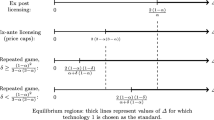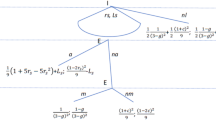Abstract
As patent licensing has become the prime driver of technology trade, understanding the rationales behind a properly-defined payment structure of the agreements is essential. Specifically, among the other remuneration components, upfront fees are critical in license negotiations since they imply a significant initial investment by the licensee and represent a source of liquidity for the licensor. We investigate how contractual flexibility, market uncertainty and technical uncertainty shape upfront fees from the licensee’s perspective. Upfront fees are shown to be positively associated with contractual flexibility and market uncertainty, while technical uncertainty is positively associated with upfront fees only if the license warrants contractual flexibility to the licensee. Licensees therefore do not necessarily see uncertainty as a negative attribute of a patent license, but rather as a potential value, above all if in presence of contractual flexibility.
Similar content being viewed by others
Notes
These acronyms are drawn from the Security Exchange Commission official webpage (available at https://www.sec.gov/forms#.VRPNlI54pNM, retrieved on the 26 March 2015): they refer to Annual report (10-K), Registration statement (S-1) and Current report (8-K).
Datastream is a proprietary dataset for macroeconomic analysis, own by Thomson Reuters, available at http://financial.thomsonreuters.com/en/products/tools-applications/trading-investment-tools/datastream-macroeconomic-analysis.html?gclid=CMPkserE-MQCFYHKtAodAjYA8g.
Kamien and Tauman (1984) debated zero upfront payments by studying the choice between fixed fee and royalty-based contracts in a game theoretical context. This literature addresses the optimal contract design of licensing agreements (see e.g. Katz and Shapiro 1985; Gallini and Wright 1990). The Heckman approach results are depicted in the appendix in Table 3.
For a discussion on the role of bargaining power in licensing contracts, see Sakakibara (2010).
As noted by one of our reviewers, it would have been useful also to control for whether the licensor was an NPE. We, however, do not observe any NPEs in our dataset.
References
Alchian, A., & Demsetz, H. (1972). Production, information costs and economic organization. American Economics Review, 62, 777–795.
Anand, B. N., & Khanna, T. (2000). The structure of licensing contracts. The Journal of Industrial Economics, 48, 103–135.
Arora, A., Fosfuri, A., & Gambardella, A. (2001). Markets for technology: The economics of innovation and corporate strategy. Cambridge: The MIT Press.
Arora, A., & Gambardella, A. (2010). Ideas for rent: An overview of markets for technology. Industrial and Corporate Change, 19(3), 775–803.
Åstebro, T., & Dahlin, K. (2005). Opportunity knocks. Research Policy, 34, 1404–1418.
Athreye, S., & Cantwell, J. (2007). Creating competition? Globalisation and the emergence of new technology producers. Research Policy, 36(2), 209–226.
Baldi, F., & Trigeorgis, L. (2014). IP licensing: How to structure a good deal. Sinergie, 93, 55–78.
Bessy, C., & Brousseau, E. (1999). Technological licensing contracts: Features and diversity. International Review of Law and Economics, 18, 451–489.
Bloom, N., & Van Reenen, J. (2002). Patents. Real options and firm performance. Economic Journal, 112, C97–C116.
Brickley, J. A. (2002). Royalty rates and upfront fees in share contracts: Evidence from franchising. The Journal of Law, Economics and Organization, 18, 511–535.
Ceccagnoli, M., Graham, S. J. H., Higging, M. J., & Lee, J. (2010). Productivity and the role of complementary asstes in firms’ demand for technologiy innovations. Industrial and Corporate Change, 19(3), 839–869.
Ceccagnoli, M., & Jiang, L. (2013). The cost of integrating external technologies: Supply and demand drivers of value creation in the markets for technology. Strategic Management Journal, 34(4), 404–425.
Chambers, C. G., Snir, E. M., & Ata, A. (2009). The use of flexible manufacturing capacity in pharmaceutical product introductions. Decision Sciences, 40, 213–241.
CNS (1995). Material contract. SEC. http://www.sec.gov/edgar/searchedgar/companysearch.html.
Cockburn, I. M. (2007). Is the market for technology working? Obstacles to licensing inventions and ways to license inventions and ways to reduce them. In: Conference on economics of technology policy, Monte Verità.
Cockburn, I. M., MacGarvie, M. J., & Muller, E. (2010). Patent thickets, licensing and innovative performance. Industrial and Corporate Change, 19(3), 899–925.
Dechenaux, E., Goldfarb, B., Shane, S., & Thursby, M. C. (2008). Appropriability and commercialization: Evidence from MIT inventions. Management Science, 54, 893–906.
Dechenaux, E., Thursby, M., & Thursby, J. (2009). Shirking, sharing risk and shelving: The role of university license contracts. International Journal of Industrial Organization, 27(1), 80–91.
Dechenaux, E., Thursby, J., & Thursby, M. C. (2011). Inventor moral hazard in university licensing: The role of contracts. Research Policy, 40, 94–104.
Erutku, C., & Richelle, Y. (2007). Optimal licensing contracts and the value of a patent. Journal of Economics and Management Strategy, 16(2), 407–436.
Exactech (1996). Annual report. SEC. http://www.sec.gov/edgar/searchedgar/companysearch.html.
Fosfuri, A. (2006). The licensing dilemma: Understanding the determinants of the rate of technology licensing. Strategic Management Journal, 27, 1141–1158.
Gallini, N., & Wright, B. (1990). Technology transfer under asymmetric information. Journal of Economics, 21, 147–160.
Gans, J. S., Hsu, D. H., & Stern, S. (2008). The impact of uncertain intellectual property rights on the market for ideas: Evidence from patent grant delays. Management Science, 54, 982–997.
Garud, R., & Nayyar, P. R. (1994). Transformative capacity: Continual structuring by intertemporal technology transfer. Strategic Management Journal, 15(5), 365–385.
Gilbert, R. J., & Newbery, D. M. (1982). Preemptive patenting and the persistence of monopoly. The American Economic Review, 72(3), 514–526
Hall, B., Jaffe, A., & Trajtenberg, M. (2001). The NBER patent citations data file: Lessons, insights and methodological tools. NBER working paper 8498
Harhoff, D., Scherer, F. M., & Vopel, K. (2003). Citations, family size, opposition and the value of patent rights. Research Policy, 32, 1343–1363.
Huchzermeier, A., & Lock, C. H. (2001). Project management under risk: Using the real option approach to evaluate flexibility in R&D. Management Science, 47, 85–101.
Jordan, W. C., & Graves, S. C. (1995). Principles on the benefits of manufacturing process flexibility. Management Science, 41, 577–594.
Kamien, M., & Tauman, Y. (1984). The private value of a patent: A game theoretical analysis. Zeitschrift für Nationalökonomie, 4, 93–118.
Kamiyama, S., Sheehan, J., & Martinez, C. (2006). Valuation and exploitation of intellectual property. OECD. STI working paper series.
Katz, M. L., & Shapiro, C. (1985). Technology adoption in the presence of network externalities. Journal of Political Economy, 94, 822–841.
Klein, B., Crawford, R., & Alchian, A. (1978). Vertical integration, appropriable rents and the competitive process. Journal of Law, Economics and Organizations, 21, 297–326.
Kulatilaka, N., & Lin, L. (2006). Impact of licensing on investment and financing of technology development. Management Science, 52, 1824–1837.
Lafontaine, N. (1992). Agency theory and franchising: Some empirical results. RAND Journal of Economics, 23, 263–283.
Lafontaine, N., & Shaw, L. S. (1999). The dynamics of franchise contracting: Evidence from panel data. Journal of Political Economy, 107, 1041–1080.
Lanjouw, J. O., & Schankerman, M. (2001). Characteristics of patent litigation: A window on competition. RAND Journal of Economics, 31, 129–151.
Lemley, M. A., & Shapiro, C. (2005). Probabilistic patents. Journal of Economic Perspectives, 19, 75–98.
Lemley, M. A., & Shapiro, C. (2007). Patent holdup and royalty stacking. Texas Law Review, 85, 1991–2049.
Leone, M. I., & Reichstein, T. (2012). Licensing-in fosters rapid invention! the effect of the grant-back clause and technological unfamiliarity. Strategic Management Journal, 33, 965–985.
Merchant, H., & Schendel, D. (2000). How do international joint ventures create shareholder value. Strategic Management Journal, 21, 723–737.
Miller, K. D., & Folta, T. B. (2002). Option value and entry timing. Strategic Management Journal, 23, 655–665.
Mulotte, L., Dussauge, P., & Mitchell, W. (2013). Does pre-entry licensing undermine the performance of subsequent independent activities? Evidence from the global aerospace industry, 1944–2000. Strategic Management Journal, 34(3), 358–372.
Mundlak, Y. (1978). On the pooling of time-series and cross section data. Econometrica, 46, 69–85.
Murray, M. P. (2006). Avoiding invalid instruments and coping with weak instruments. Journal of Economic Perspectives, 20, 111–132.
Oriani, R., & Sobrero, M. (2008). Uncertainty and the market valuation of R&D within a real options logic. Strategic Management Journal, 29, 343–361.
Parr, R. L., & Smith, G. V. (2005). Intellectual property: Valuation, exploitation and infringement damages. Hoboken: Wiley.
Parr, R. L., & Sullivan, P. H. (1996). Technology licensing: corporate strategies for maximizing value. New York: Wiley.
Pfeffer, J. (1981). Power in organizations. Marshfield: Pitman Publishing Company.
Razgaitis, R. (2003). Valuation and pricing of technology-based intellectual property. Hoboken: Wiley.
Razgaitis, R. (2004). US/Canadian licensing in 2003: Survey results. Journal of the Licensing Executives Society, 39(4), 139–151.
Reimann, M., & Schiltknecht, P. (2009). Studying the interdependence of contractual and operational flexibilities in the market of specialty chemicals. Eurpoean Journal of Operational Research, 198, 760–772.
Reitzig, M. (2004). Strategic management of intellectual property. MIT Sloan Management Review, 45, 35–40.
Sakakibara, M. (2010). An empirical analysis of pricing in patent licensing contracts. Industrial and Corporate Change, 19, 927–945.
Scherer, F., & Harhoff, D. (2000). Technology policy for a world of skew-distribution outcomes. Research Policy, 29, 559–566.
Thursby, M. C., Thursby, J., & Dechenaux, E. (2005). Shirking, sharing risk, and shelving: The role of university license contracts. NBER working paper #11128
Trajtenberg, M. (1990). A penny for your quotes: Patent citations and the value of innovations. Rand Journal of Economics, 21, 172–187.
Tsay, A. A. (1999). The quantity flexibility contract and supplier-customer incentives. Management Science, 45, 1339–1358.
Vonortas, Y., & Kim, N. S. (2006). Technology licensing partners. Journal of Economics and Business, 58, 273–289.
Ziedonis, A. A. (2007). Real options in technology licensing. Management Science, 53, 1618–1633.
Acknowledgments
We thank the Financial Valuation Groups for allowing us to use their data on Licensing Contracts. We thank Marco Ceccagnoli, Andrea Fosfuri, Alfonso Gambardella, Marco Giarratana and Thomas Rønde for valuable comments and suggestions on earlier drafts. We also gratefully acknowledge the financial support from the Italian Ministry of University and Research (PRIN Project, CUP B41J12000160008).
Author information
Authors and Affiliations
Corresponding author
Appendix
Rights and permissions
About this article
Cite this article
Isabella Leone, M., Oriani, R. & Reichstein, T. How much are flexibility and uncertainty worth in patent licensing?. Econ Polit Ind 42, 371–394 (2015). https://doi.org/10.1007/s40812-015-0020-7
Received:
Revised:
Accepted:
Published:
Issue Date:
DOI: https://doi.org/10.1007/s40812-015-0020-7




